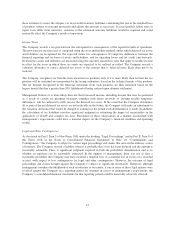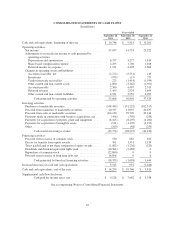Apple 2013 Annual Report Download - page 52
Download and view the complete annual report
Please find page 52 of the 2013 Apple annual report below. You can navigate through the pages in the report by either clicking on the pages listed below, or by using the keyword search tool below to find specific information within the annual report.Notes to Consolidated Financial Statements
Note 1 –Summary of Significant Accounting Policies
Apple Inc. and its wholly-owned subsidiaries (collectively “Apple” or the “Company”) designs, manufactures,
and markets mobile communication and media devices, personal computers, and portable digital music players,
and sells a variety of related software, services, peripherals, networking solutions, and third-party digital content
and applications. The Company sells its products worldwide through its retail stores, online stores, and direct
sales force, as well as through third-party cellular network carriers, wholesalers, retailers and value-added
resellers. In addition, the Company sells a variety of third-party iPhone, iPad, Mac, and iPod compatible
products, including application software, and various accessories through its online and retail stores. The
Company sells to consumers, small and mid-sized businesses, and education, enterprise and government
customers.
Basis of Presentation and Preparation
The accompanying consolidated financial statements include the accounts of the Company. Intercompany
accounts and transactions have been eliminated. The preparation of these consolidated financial statements in
conformity with U.S. generally accepted accounting principles (“GAAP”) requires management to make
estimates and assumptions that affect the amounts reported in these consolidated financial statements and
accompanying notes. Actual results could differ materially from those estimates. Certain prior period amounts in
the consolidated financial statements and notes thereto have been reclassified to conform to the current period’s
presentation.
The Company’s fiscal year is the 52 or 53-week period that ends on the last Saturday of September. The
Company’s fiscal years 2013, 2012 and 2011 ended on September 28, 2013, September 29, 2012 and
September 24, 2011, respectively. An additional week is included in the first fiscal quarter approximately every
six years to realign fiscal quarters with calendar quarters. Fiscal year 2012 spanned 53 weeks, with a 14th week
included in the first quarter of 2012. Fiscal years 2013 and 2011 spanned 52 weeks each. Unless otherwise stated,
references to particular years, quarters, months and periods refer to the Company’s fiscal years ended in
September and the associated quarters, months and periods of those fiscal years.
During the first quarter of 2013, the Company adopted amended accounting standards that changed the
presentation of comprehensive income. These standards increased the prominence of other comprehensive
income (“OCI”) by eliminating the option to present components of OCI as part of the statement of changes in
shareholders’ equity and required the components of OCI to be presented either in a single continuous statement
of comprehensive income or in two consecutive statements. The amended accounting standards only impacted
the financial statement presentation of OCI and did not change the components that are recognized in net income
or OCI; accordingly, the adoption had no impact on the Company’s financial position or results of operations.
Revenue Recognition
Net sales consist primarily of revenue from the sale of hardware, software, digital content and applications,
peripherals, and service and support contracts. The Company recognizes revenue when persuasive evidence of an
arrangement exists, delivery has occurred, the sales price is fixed or determinable, and collection is probable.
Product is considered delivered to the customer once it has been shipped and title and risk of loss have been
transferred. For most of the Company’s product sales, these criteria are met at the time the product is shipped.
For online sales to individuals, for some sales to education customers in the U.S., and for certain other sales, the
Company defers revenue until the customer receives the product because the Company retains a portion of the
risk of loss on these sales during transit. The Company recognizes revenue from the sale of hardware products,
software bundled with hardware that is essential to the functionality of the hardware, and third-party digital
content sold on the iTunes Store in accordance with general revenue recognition accounting guidance. The
Company recognizes revenue in accordance with industry specific software accounting guidance for the
50
























